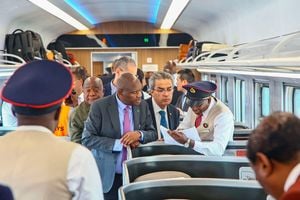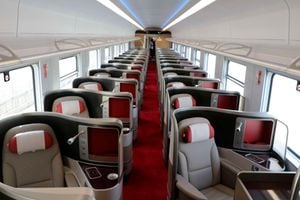
Passengers queue to board the Madaraka Express SGR train in Nairobi.
Passenger traffic on the standard gauge railway (SGR) services fell by more than 100,000 in the first half of the year after Kenya Railways Corporation raised fares by half to boost revenues.
Latest disclosures show nearly 1.13 million tickets were sold in the six months compared with 1.25 million in the same period last year.
The 121,023, or 9.68 per cent, drop in passengers was the first in the post-pandemic period, analysis of data from the Kenya Railways Corporation indicates.
This came in a period when KRC raised fares on the Nairobi-Mombasa SGR line by 50 per cent to Sh1,500 from Sh1,000 previously for economy class seats in January, while the rates for first-class seats climbed to Sh4,500 from Sh3,000.
The increase in fares on Kenya’s most expensive infrastructure since independence was “informed by changes in the energy and petroleum sector where prices of fuel have significantly increased thus affecting the cost of our operations”.
The strategy appears to be paying off with Africa Star Railway Operations Company (Afristar) reporting a considerable 35.16 per cent jump in revenue from SGR passenger services to Sh1.85 billion in the half-year period from Sh1.37 billion a year ago.
Afristar, a subsidiary of the China Road and Bridge Corporation, operates and maintains the line which runs from the coastal city of Mombasa to Suswa near Naivasha via the capital Nairobi under a 10-year concession from 2017.
This came amid mounting pressure on KRC to start reimbursing the $3.75 billion (Sh487.5 billion under prevailing dollar conversion rates) Chinese loan procured to build the line. Treasury disclosed that Kenya Railways was yet to start reimbursing billions of shillings taxpayers spend on servicing the loan Kenya procured from Exim Bank of China.
The parastatal last June accounted for nearly 60 per cent of the Sh983.20 billion loan arrears, which the Treasury borrowed on behalf of strategic State-owned enterprises over the years.
“The total outstanding on-lent loan arrears for SOEs was Sh983,204 million as at end of June 2023; out of which Sh566,120 million accounting for about 57.6 per cent of the total amount is on-lent to Kenya Railways Corporation in support of the standard gauge railway project,” the Treasury said in the Annual Public Debt Management report for the financial year ended June 2023.
Details of when and how the KRC should reimburse the SGR repayments are secretive, just like the loan agreement between Nairobi and Beijing.
Kenya constructed nearly 700 kilometres of SGR line between Mombasa and Suswa with China funding over 90 per cent of the estimated cost of $3.75 billion.
The line was initially planned to run up to Malaba but terminated at the sleepy Suswa area after China demanded that Kampala commit to constructing its section before Beijing releases funding for the third phase.
Uganda has since contracted a Turkish firm M/s Yapi Merkezi to build an SGR line from the Kenya-Uganda border at Malaba to Kampala.







